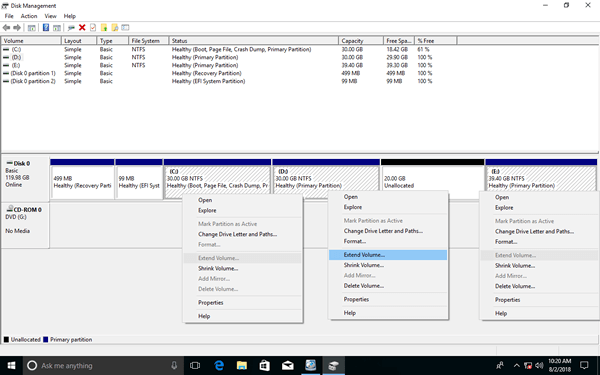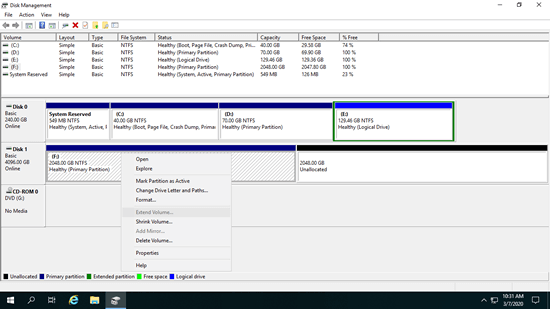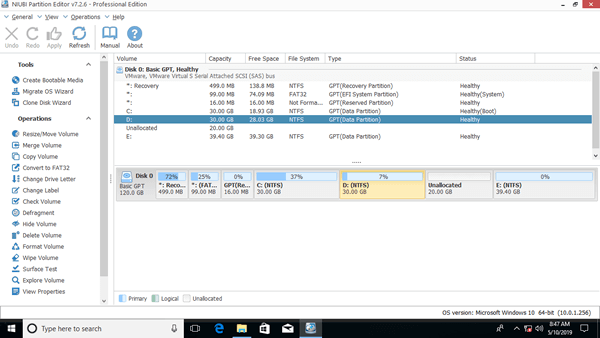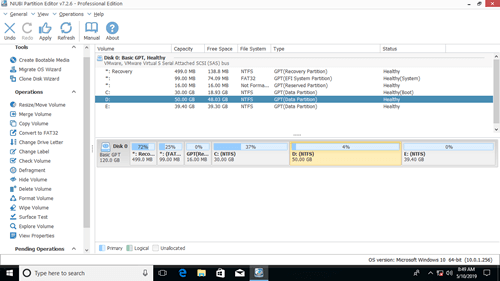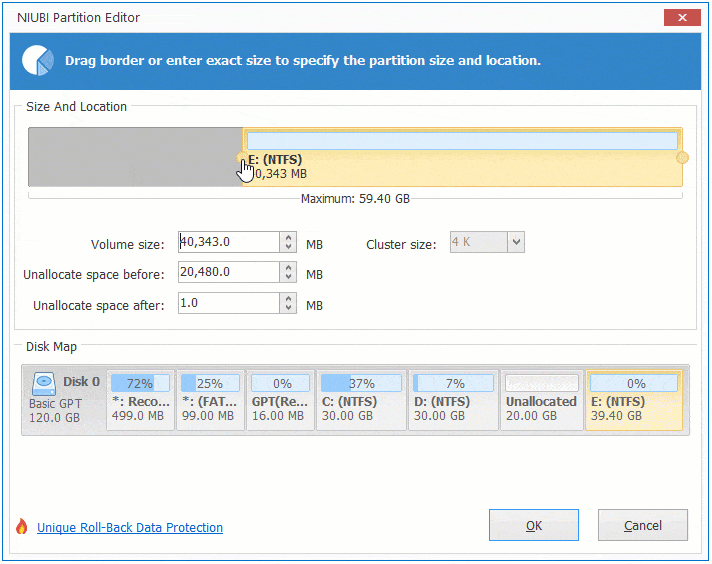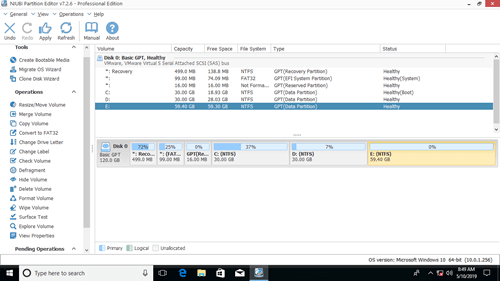"Unallocated" space is kind of disk space that is not allocated to any partition. Beside creating new volume, Unallocated space can be used to extend other partition. To get Unallocated space, you may either delete or shrink a partition. Better than deleting a partition, you won't lose data by shrinking a partition.
When system C: drive is running out of space, many people want to shrink D drive to get Unallocated space and add to C drive. If you did shrink D drive with Disk Management, you know that this Windows native tool cannot merge Unallocated space to C drive. In this article, I'll introduce how to merge Unallocated space in Windows 10/8/7 computer with free partition software.

Why Disk Management can't merge Unallocated space
There are 2 types of native tools in Windows 10/8/7 - Diskpart and Disk Management. Diskpart is a command line tool, Disk Management has graphic interface. Although they work in different way, they have same shortages while merging Unallocated space to a partition in Windows 10/8/7:
- They can only combine Unallocated space to NTFS partition, FAT32 any other types of partitions are not supported.
- They can only merge Unallocated space to the contiguous partition on the left.
- They cannot merge Unallocated space to a nonadjacent partition or to the contiguous partition on the right.
Many people successfully shrunk D drive to get Unallocated space via Disk Management, but they cannot merge Unallocated space to C drive in Windows 10/8/7, why? Because the native tools can only make Unallocated space on the right while shrinking D (and other partition), this Unallocated space is nonadjacent to C drive and is on the left of E drive. Therefore, Extend Volume is greyed out for both partitions.
If you want to merge Unallocated space to C drive in Windows 10/8/7 without any software, you must delete D: drive to get contiguous Unallocated space. If you want to merge Unallocated space to E drive (adjust partition on the right), Disk Management (and diskpart) cannot help you.
Note: do not delete D drive if you installed programs in it. If D is a Logical drive, Disk Management is unable to extend C drive even after deleting D.
Another probable reason why you cannot merge Unallocated space to a partition in Windows 10/8/7 is related to MBR disk limitation. On a MBR disk, you can only create maximum 2TB partition. If you want to combine more Unallocated space to it, you must convert MBR disk to GPT in advance.
Merge Unallocated space in Windows 10/8/7 with free software
To combine Unallocated space to a partition in Windows 10/8/7 computer, you'd better run third party software. There are many choices, but among them all, NIUBI Partition Editor is much better, because it has 1-Second Rollback, Virtual Mode, Cancel-at-will and Hot-Clone technologies to protect your system and data. It has free edition for Windows 11/10/8/7/Vista/XP home computer users. To move and combine Unallocated space, you just need to drag and drop on the disk map.
Download the free edition and you'll see the main window with disk partition structure and other information.
1. How to merge Unallocated space to C drive (nonadjacent)
If you've shrunk D drive in Disk Management, Unallocated space was made on the right of D. To merge this Unallocated space to C drive, you must move Unallocated space to the left in advance, and then combine to C drive.
Steps to merge Unallocated space to C drive in Windows 10/8/7 with NIUBI:
- Right click D: drive and select "Resize/Move Volume", drag the middle of D drive towards right in the pop-up window, then Unallocated space will be moved to the left side.
- Right click C: drive and select "Resize/Move Volume" again, drag right border towards right to merge this Unallocated space to C: drive.
- Click Apply on top left to confirm and execute. (To avoid mistake, all operations you do will be listed as pending, real disk partitions won't be modified until click Apply to confirm.)
Follow the steps in the video:
If you use any types of hardware RAID arrays, or run Windows 10 as guest virtual machine in VMware or Hyper-V, simply follow the same steps in the video, there's no difference. In some computers, the contiguous drive is E. In that case, replace D with E in above steps.
2. How to merge Unallocated space to D/E drive (adjacent)
To merge Unallocated space in Windows 10/8/7 to a contiguous partition, it is very easy with NIUBI Partition Editor, there's only one step, following the methods below.
① Merge Unallocated space to D drive (left adjacent partition):
Right click D: drive and select Resize/Move Volume, drag right border towards right in the pop-up window.

Then Unallocated space is merged into D drive.
If you want to add Unallocated space to a 2TB partition, follow the step to convert MBR disk to GPT and then follow the method above.
3. Merge Unallocated space to another disk
In some computers, there's no data volume on the system disk, or there's not enough free space on the same disk. Some people are wondering whether it's possible to add Unallocated space to C drive from a different disk. The answer is no, because the size of a physicaldisk is fixed. You can resize a partition but you cannot shrink or expand a disk (except virtual disk).
To solve this problem, there are two options with NIUBI Partition Editor:
- Move a partition to another disk, delete it to get Unallocated space and then add to C drive.
- Copy whole disk to a larger one and extend partition with additional disk space.
If you use virtual machine, it is much easier, you can expand original virtual disk following the steps in VMware or Hyper-V. After expanding disk, additional space is shown as Unallocated at the end of disk, then follow the steps above to move and merge Unallocated space to C drive or other partition.
Besides move and merge Unallocated space in Windows 11/10/8/7/Vista/XP, NIUBI Partition Editor helps do many other operations such as copy, convert, defrag, wipe, hide partition, scan bad sectors, optimize file system and much more.

